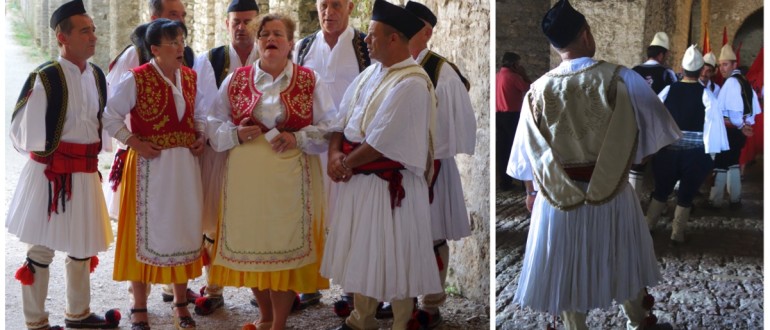The Second Symposium of the ICTM Study Group for Multipart Music was held in Tiranë and Vlorë from 22-29 April 2012. The conference was accompanied by a series of concerts of traditional polyphony from different countries of Europe. The conference was organized by Ulysses Foundation (Tiranë, Albania) and Institut für Volksmusikforschung and Ethnomusikologie Universität für Musik und darstellende Kunst Wien (Austria).
Themes of meeting were: 1. Multipart music practices as creative processes. 2. Multipart music in religious practices. 3. Multipart music awarded.
Here is the list of participants and their papers:
- Ardian AHMEDAJA (Austria/Albania). |“Intervals and timbre in local multipart music practices in Southern Albania”.
- Jaume AYATS (Spain). “Constructing collectivity: Multipart singing in parallel 5ths or 4ths in the Western Mediterranean”.
- Mauro BALMA (Italy). “From monody to polyphony: a creative path inside the experience of Genoese trallalero (Italy)”.
- Anda BEITANE (Latvia). “Multipart singing in Latvian traditional music: awards and everyday practice”.
- Paolo BRAVI (Italy). “Micro-creativity. Glottal stops in cauda as stylistic marks in the Sardinian a tenore singing”.
- Josko ĆALETA (Croatia). “Klapa singing and ojkanje – Croatian multipart music repertoire examples”.
- Enrique CAMARA DE LANDA (Spain/Argentina). “Folk music revival in Argentina: the arrangement of vocal melodies”.
- Jean-Jacques CASTÉRET (France). “Collective determinims and individual expression in Pyrenean multipart singing”.
- Anne CAUFRIEZ (Belgium). “The female polyphony of northern Portugal. (Minho and Trás-os-Montes provinces)”.
- Girolamo GAROFALO (Italy). “Multipart singing among the Arbëresh of Sicily: the ison in the Byzantine Chant and the biphony in the paraliturgical repertoires”.
- Cristina GHIRARDINI (Italy). “Two-part parallel singing in Romagna: the present and the past”.
- Ursula HEMETEK (Austria). “Romani songs as Intangible Cultural Heritage in Austria. Some considerations on cultural politics and minorities”.
- Larry Francis HILARIAN (Singapor). “Ritualistic practices in multipart musical cultures of urban Singapore”.
- Eno KOÇO (UK/Albania). “The iso(n) – a participatory component in southern Albanian multipart unaccompanied singing and in Byzantine Chant”.
- Gerda LECHLEITNER (Austria). “Panel abstract: Creative processes in multipart music-making”.
- Gerda LECHLEITNER (Austria). and Nona LOMIDZE (Austria/Georgia). “Production and process – creative acting and perceiving”.
- Wei-Ya LIN (Austria/Taiwan) “Multipart singing in the society of Tao (an aboriginal tribe in Taiwan)”.
- Bernard LORTAT-JACOB (France) “Public lecture: Singing and drinking. Analysis of a very common duality”.
- Ignazio MACCHIARELLA (Italy). “Secondary orality and creativity processes in multipart singing”.
- Renato MORELLI (Italy). “Film presentation. Voices from the Heights: three days in Premana”.
- Bożena MUSZKALSKA (Poland). “Polyphony of voices in Jewish religious traditions”.
- Ieva PĀNE (Latvia) The dimentions of creativity in derivation, formation and modification of musical practice
- Žanna PÄRTLAS (Estonia). “On musical creativity in the “text-oriented” song tradition: the processes of melodic variation in the Setu multipart songs”.
- Ankica PETROVIĆ (Croatia/USA). “The phenomenon of multipart chant in world religions”.
- Rudolf PIETSCH (Austria). “Examples of particular multipart music appearances in folk music in Austria”.
- Eckehard PISTRICK (Germany) and Bledar KONDI (Albania/Germany) ““Waiting for the sea to dry up” Migration songs for the (un)buried victims of Otranto and the free form of collective funeral crying and mourning in Labëria”.
- Jakša PRIMORAC (Croatia). “Glagolitic singing: A new life of an ancient chant of Adriatic Croatia”.
- Daiva RAČIŪNAITĖ-VYČINIENĖ (Lithuania). “Sutartinės, Lithuanian multipart songs in UNESCO’s Intangible Cultural Heritage List: winning and risk”.
- Nicola SCALDAFERRI (Italy) Multipart singing as a marker of the local identity. Some examples from the Arbëresh villages of southern Italy.
- Laxmi G. TEWARI (USA) “Birhana: An Indian folk genre in Trinidad & Tobago”.
- Susanne ZIEGLER (Germany) “Georgian church singing and its revitalization”.





